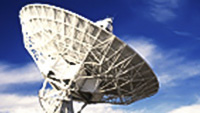Search and order online
Cryosat Mission
- Video Tape only
- Title Cryosat Mission
- Released: 22/05/2005
- Language English
- Footage Type Documentary
- Copyright ESA
- Description
Cryosat Mission
ESA TV Exchanges
ESA's Cryosat satellite is a radar altimetry mission to observe polar regions and continental glaciers. Its aim is to determine any changes in the thickness of the Earth's continental ice sheets and marine sea ice cover. Ice sheets have a central role in the global climate. Although thousands of kilometres away from most populated regions, the ice can determine the climate for example in Europe, Asia and America by influencing the circulation of water in the oceans. The Arctic is the region on Earth where the greatest changes in ice cover due to global warming are predicted.
Cryosat will help to determine whether the polar ice sheets are actually shrinking or not, and at which rate. The satellite will be launched on a Rockot vehicle from Plessetsk in Russia in autumn 2005.
Today's Exchnage provides the footage to outline the case for the Cryosat mission, featuring soundbites by Pr. Duncan Wingham from University College London, who proposed the mission in 1997/98 and todayGreenland; Cryosat
earth observation; global warming
ice caps melting; ice caps measuring
Sighral instrument
Iceberg; Ice
Cryosat Mission
Start A- Roll : TC : 10.00.40
One of the most hotly debated questions amongst scientists and politicians at the moment is whether global warming is responsible for melting of the polar ice sheets? Some scientist s believe we are at a crucial moment in history, especially when it comes to the future of the Greenland Ice sheet and Artic sea Ice.
Quote: Duncan Wingham/Lead investigator, Cryosat
""The present situation is delicately poised, in Greenland there is plenty of information that the melting is accelerating and once Greenland starts to melt it will get lower, because it gets lower itíll get warmer thereíll be more melt and once Greenland goes it wont come back because it will be too warm at sea level to do it. In Greenland I think were at the point of no return unless we stop the warming "".
This situation comes as no surprise to the European space agency which


